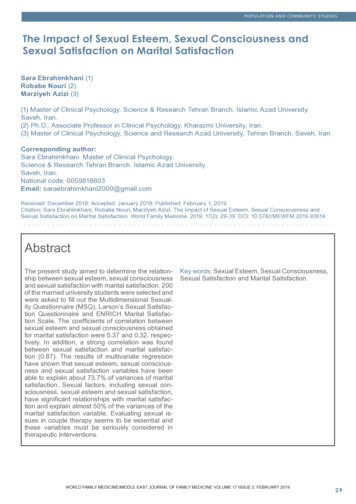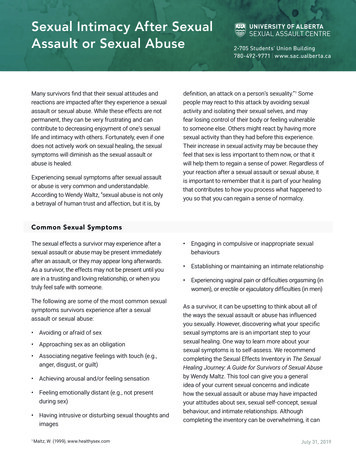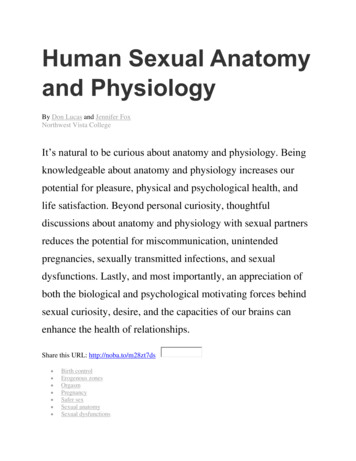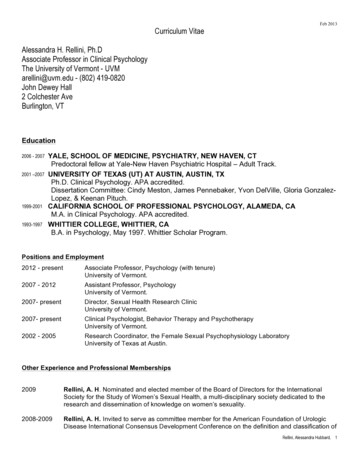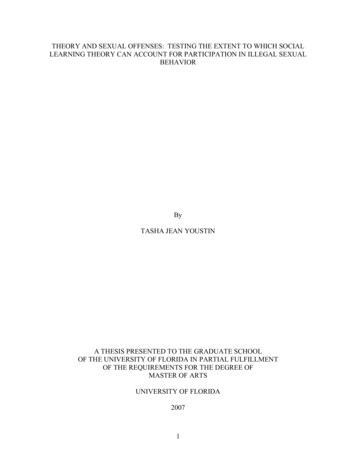
Transcription
THEORY AND SEXUAL OFFENSES: TESTING THE EXTENT TO WHICH SOCIALLEARNING THEORY CAN ACCOUNT FOR PARTICIPATION IN ILLEGAL SEXUALBEHAVIORByTASHA JEAN YOUSTINA THESIS PRESENTED TO THE GRADUATE SCHOOLOF THE UNIVERSITY OF FLORIDA IN PARTIAL FULFILLMENTOF THE REQUIREMENTS FOR THE DEGREE OFMASTER OF ARTSUNIVERSITY OF FLORIDA20071
2007 Tasha Jean Youstin2
To the people in my life who have always believed in meTo my family, whose abundant love and support has been unconditionalTo Matt, who continually inspires me to be the best that I can be- thank you for your help,patience, reassurance, and loveTo my parents, Ray and Heidie Youstin, whose selflessness and strength has made me the personI am today. Thank you for showing me that with hard work and determination, anything ispossible. I love you3
ACKNOWLEDGMENTSI thank Dr. Eve Brank and Dr. Alex Piquero, members of my supervisory committee, forthe time and effort they dedicated to this project. I would like to give special thanks to my chair,Dr. Ronald Akers, for helping me translate my ideas onto paper for the survey instrument, andfor his patience and optimism in developing the project I had envisioned. I could not have askedfor a more helpful or supportive committee.4
TABLE OF CONTENTSpageACKNOWLEDGMENTS .4LIST OF TABLES.6ABSTRACT.7CHAPTER1LITERATURE REVIEW .8Introduction: Sexual Offenses and Offenders.8History .9Contemporary Sex Offender Laws .13Sex Offenders in Florida.15Theories Dealing with Sexual Offenses .16Psychological Assessments .18Criminological Theories.202DATA AND METHODOLOGY .27Procedure .27Hypotheses.30Dependent Variable .31Independent Variables .32Demographic and Control Variables .34Data Analysis.343RESULTS .35Participant Demographics.35Distribution for Independent and Dependent Variables .35Hypothesis 1 .37Hypothesis 2 .394CONCLUSIONS .41Discussion.41Limitations.42Future Research .43APPENDIXSexual Offender Survey Questionnaire .46LIST OF REFERENCES.52BIOGRAPHICAL SKETCH .555
LIST OF TABLESTablepage3-1Descriptive statistics for select variables .363-2Non-parametric 2-independent samples t-test (Mann-Whitney U) Groups 1&2.383-3Non-parametric 2-independent samples t-test (Mann-Whitney U) Groups 3&4.406
Abstract of Thesis Presented to the Graduate Schoolof the University of Florida in Partial Fulfillment of theRequirements for the Degree of Master of ArtsTHEORY AND SEXUAL OFFENSES: TESTING THE EXTENT TO WHICH SOCIALLEARNING THEORY CAN ACCOUNT FOR PARTICIPATION IN ILLEGAL SEXUALBEHAVIORByTasha Jean YoustinAugust 2007Chair: Ronald L. AkersCochair: Eve M. BrankMajor: Criminology, Law, and SocietyWith the growing public concern over sexual offenses and offenders, in-depth research intothe causes of these crimes is essential. Despite years of research from various academic areas,there has been little theoretical consensus to explain participation in sexually deviant behavior.The present study tests the ability of one prominent criminological theory, Social LearningTheory, to explain sexually deviant behavior. A sample of convicted sexual offenders from onecounty in Florida was obtained through mail surveys. Results indicate that offenders with higherself-reported levels of participation in sexually deviant behavior scored higher and in theexpected direction when compared with offenders with lower reported participation. Theanalyses show partial support for this theory, and illustrate the need for more research into therelationship between sexually deviant behavior and social learning mechanisms. Limitations anddirections for future research are discussed.7
CHAPTER 1LITERATURE REVIEWIntroduction: Sexual Offenses and OffendersIn his 1994 book on sexual abuse, Adam Sampson begins by stating that three questionsmust be answered in order to form a theoretical background for the phenomenon of sexualoffending. Those questions are: “What do we mean by sexual offending? What causesindividuals to commit sexual offenses? And are such offenders amenable to treatment?”(Sampson, 1994: p. 1). While over a decade has passed since that statement was made, littlecohesive work has been done to form a theoretical background for sexual offending. There isclearly no global definition of a sexual offense, and even in the United States, there is no nationaldefinition for the behavior. Individual jurisdictions decide which acts are deemed as sexualoffenses, and which offenders are given a label of “sex offender.” Though some offenses arecommon throughout all jurisdictions in the US, variations in terminology make it difficult toform a national definition. For the purposes of this study, sexual offenses will refer to sexualbehaviors made illegal through law and regularly prosecuted against, such as pedophilia, viewingchild pornography, and rape. While some jurisdictions may still have laws against adultery,sodomy (such as oral or anal sex), premarital sex, and homosexuality, few cases arise every yearthat involve prosecutions for these behaviors, despite their prevalence. Because laws againstthese acts are not regularly enforced, these acts will be excluded when referring to sexualoffenses. For theories as to why individuals commit these offenses, there are psychodynamictheories, biological theories, feminist theories, attachment theories, behavioral theories, and thelist goes on and on. Terry (2006: p. 50) states, “despite years of research, theories on sexualoffending are still inconclusive it is now clear that no single explanation accuratelyencompasses the myriad factors associated with the onset of deviant behavior.” That opinion8
will be tested through future research. Regarding the effect of treatment on sex offenders, therehas been no conclusive answer to that question as well. While a recent, comprehensive metaanalysis of treatment programs found that cognitive-behavioral treatment programs could reducesexual recidivism by up to 40%, previous reviews of programs have provided a wide variety offindings (Hanson et al., 2002).The lack of agreement from researchers, mixed with the public view of sexual offenders asmonsters (Samson, 1994), has combined to create an atmosphere of hatred and fear. Thesefeelings, guided by sensationalized media coverage of rare, horrible acts of violence againstchildren, have helped to impose increasingly punitive legislation and policies on sex offenders.But while the fate of sex offenders continues to be a hot topic with politicians and news media,there is still a gross lack of understanding as to the factors that drive this crime. The purpose ofthe study at hand will be to determine the extent to which Social Learning Theory can accountfor an individual’s participation in sexual deviance. Hopefully, this research can answer at leastone of the critical questions necessary to creating a theoretical framework for understandingsexual offenses.HistoryActivities viewed in this age as sexually deviant are not all new. In fact, there areaccounts of sexually deviant acts in our earliest recorded history, from ancient Egyptian papyri tothe Bible. Von Krafft-Ebing (1922), an influential psychologist in the early 20th century,believed that psychopathia sexualis (sexually deviant behavior) was a direct result of the overstimulated sensuality of advanced culture. While his work on sexual deviance wasgroundbreaking, the idea of limiting sexual deviance to advanced culture was not accepted by allscholars. Dr. Iwan Bloch, another scholar of the time, countered von Krafft-Ebing bycommenting, “the nature of the sex impulse and of its anomalies is simply independent of all9
culture, and exhibits the same characteristics among primitive and civilized peoples” (Bloch,1933: p. 9). While it is difficult to account for sexually deviant behavior because of itssubjective nature, it is clear that there have always been sexual taboos throughout history, anddespite its constant nature, sexually deviant behavior is still a shocking occurrence to peopletoday.A closer look into history reveals that sexually acceptable behavior has varied to incredibledegrees. Pedophilia, polygamy and lewdness (such as public sex) are all acts which, at one timeor another, were viewed as completely acceptable. Around 3200 BC, the Mesopotamians(accepted as a civilized culture) culminated their religious ceremonies with the Akita festival.During this festival, the high priest and priestess would celebrate the religious experience withsexual intercourse in front the congregation (Holmes, 1983). Jewish families illustrated in theOld Testament were structured around polygamy, a practiced that was not only accepted, but alsomorally legitimate. Pedophilia was a common practice among the ancient Greeks, who viewedthe highest form of love as that between an adult male and a prepubescent boy (Holmes andHolmes, 2002). Yet, while homosexuality was institutionalized in Greek society, relationshipsbetween adult males and male adolescents who had reached puberty were taboo.Just as acceptable sexual practices have varied throughout history, punishments forparticipation in sexually deviant acts have also varied. In some cultures, illegal sexual acts wereviewed as egregious actions against society, calling for the death of the offender, as seen inancient texts such as the old testament book of Deuteronomy. At one point in ancient Greekculture, the punishment for rape under Solon’s law was only a monetary fine (Cole, 1984). Thepunishments have seemed to reflect the general attitudes at the time towards sex within differentcultures, and as views towards sexuality became increasingly strict or conservative, the gravity10
of sex crimes increased. In the United States, definitions and punishments for sexual crimeshave also changed with the shifting views on sexuality.The U.S. has always maintained laws identifying sex crimes. The first official laws againstsexual acts, seen in the colonial law codes, were justified as moral laws because the acts wereconsidered grave sins (Jenkins, 1998). Morality laws, which found acts such as homosexuality,adultery, and oral sex to be illegal, regardless of consent, were enforced in some jurisdictionsuntil 1961. It is difficult to identify the rate of occurrence for serious sexual crimes in Americabefore the middle of the twentieth century for a few reasons. First, it is hard to distinguishbetween lesser or severe sex crimes in official records because most acts, includinghomosexuality, were simply identified as “crimes not to be named among Christians” (Jenkins,1998: p. 22). In addition, age of consent for sexual activity has changed multiple times, withdifferent states maintaining different ages of consent. At one point, the age of consent was 21 inTennessee and 7 in Delaware. Another problem was the effect of a woman’s sexual history indetermining the charge against her offender. In states such as North Carolina and West Virginia,the charge of rape could only be used if the victim was a virgin prior to the incident. Also, dueto the social implications of being a victim of a sexual offense, it is believed that a majority ofsexual crimes were unreported (Jenkins, 1998).Over the past century, concepts of sexuality and perceptions of dealing with sexuallydeviant behavior have gone through three identifiable periods in the United States (Terry, 2006).The first, ranging from 1885 to 1935, saw what is considered the first wave of panic, as thepublic first took notice in mass to sexual deviants. This period was precipitated by the work ofpsychologists such as Freud and Krafft-Ebbing before the start of the 20th century, whoseresearch on sexual deviant behavior opened the doors for the world to discuss and focus on these11
offenders. Also adding to the concern over sexuality was the Women’s Christian TemperanceMovement, who called for the age of consent to be raised to 18 years old, due to a growingnumber of women in the work place who could be taken advantage of and “sexually corrupted.”A string of cases given high media coverage between 1910 and 1915 led to the first panic oversexual killers and perverts. During this time, chemical castration was a common “treatment” forsexual offenders, and indeterminate sentences were frequently used. By the mid 1920s the panicagainst “stranger danger” cooled and the focus was put on child molestation and incest due torising venereal diseases among children.The second period extended from 1936 to 1976 and saw the emergence of what is termedthe “sexual psychopath.” The horrific story of Albert Fish, a renowned child killer, permeatedthrough the minds of the public in the mid 1930s. 1 The renewed concern over sexual deviantsled to a crackdown against sexual offenses, which saw increasing arrests for sexual offenses.While the increase in arrests seemed to suggest that sexual offenses were on the rise, the majorityof the arrests were for homosexual activity, or minor sexual offenses such as frotteurism(rubbing ones genitals against another person, usual in public places). The focus at the time wason rare habitual sexual offenders, and led to the creation of the term “sexual psychopath” byresearchers. Because criminal sanctions did not seem to be enough to deal with the problem ofthese offenders, sexual psychopath legislation was passed to allow sexual offenders to becommitted to mental hospitals for indefinite amounts of time (Terry, 2006). This legislation hadmany flaws, including the fact that there was no uniform definition of sexual psychopath, and as1Albert Fish, known as the Grey Man, was responsible for the abduction, torture and murder of numerous childrenin and around New York during the first part of the 20th century. Despite the unalarming looks of this frail old man,Fish committed some of the most gruesome acts imaginable, making a habit of sexually assaulting his victims,before murdering and dismembering them, and then participating in cannibalism.12
such, varied from state to state. The panic over sexual offenses dissipated by the 1960s and1970s as the “liberal era” brought about a social and sexual revolution. Sexual psychopath lawsfell into disuse, and the public began to question what was sexually deviant.Despite a short period free from panic over sexually deviant behavior, the third period,which ranged from 1977 to present day, saw the emergence of the sexually violent predator(Terry, 2006). Highly publicized child murders led to legislation which focused on harsherpenalties for sexual offenders, and systems which try to alert the public to the presence of theseoffenders. This legislation also awakened the sexual psychopath legislation, which had beendormant for some time. Amendments were made to the previous sexual psychopath legislationto allow civil commitment to be used to supplement incarceration instead of replace it. Theseamendments made it so offenders deemed as sexually violent predators could be committedindefinitely, immediately following a jail sentence, without the possibility of being released intothe public again. The next section discusses the current state of sex offender laws in more detail.Contemporary Sex Offender LawsIn the 1990s, America saw an increased fear and awareness of sex offenders, as illustratedin various acts passed by legislation that targeted perpetrators of sex crimes. The first act in awave of legislation was the Jacob Wetterling Crimes Against Children and Sexually ViolentOffender Registration Act, 1994. This act was named in honor of Jacob Wetterling, an 11-yearold boy who was abducted in 1989 by a masked man while Jacob was riding his bike home fromthe convenience store in Minnesota with his brother and a friend. He was never found. It waslater discovered that local halfway houses in Minnesota housed sex offenders after their releasefrom prison, and it is believed that one such resident was responsible for the abduction (Bureauof Justice Assistance, 2007). The Wetterling Act required that 10% of a states funding from theEdward Bryne Memorial State and Local Law Enforcement Assistance grant program be used to13
create and maintain state-wide systems for registering and tracking convicted sex offenders(Sample and Bray, 2003). This was the first national requirement for state sex offenderdatabases. The act also encouraged states to collect DNA samples from sex offenders for storagein databases. Although this act was originally created to focus on sex offenses against children,all 50 states have expanded their registries to include offenders of violent or nonviolent sexcrimes against any person, regardless of age (Scholle, 2000).The attention of millions of Americans was held in 1993 and 1994 by the media coverageof two young girls, Polly Klass and Megan Kanka. Polly Klass, in 1993, was abducted from herCalifornia home, sexually assaulted, and murdered. A year later, Megan Kanka was also takenfrom her New Jersey home, sexually assaulted, and murdered. Both girls were victimized bypreviously convicted sex offenders who were released from prison. These crimes led to thecreation of Megan’s Laws in 1996, an amendment to the Wetterling act, which requires sexoffender registry information be made available to the public (Sample and Bray, 2003). Anotheract passed in 1996 was the Pam Lychner Sexual Offender Tracking and Identification Act. Thisact mandated the creation of a national database of all sex offender registries (Scholle, 2000).The Wetterling Act was again modified with the passage of the PROTECT amendment. 2 Thisamendment made it mandatory for states to create and maintain internet websites containing sexoffender registration information (Levenson and Cotter, 2005).Florida has had a variety of changes to sexual offender policies over the past decade. In1997, Florida legislation enacted chapter 97-184 of Florida laws, allowing for the sentencing ofsexual batterers to chemical castration. Sexual offenders who are sentenced to weekly injectionsof medroxyprogesterone acetate (MPA) can, however, choose physical castration instead, if they2Prosecutorial Remedies and Other Tools to End the Exploitation of Children Today Act, 2003.14
so wish (Spalding, 1998). Florida’s Jimmy Ryce Act became effective in 1999. This act wascreated after Jimmy Ryce, a 9-year-old boy from South Florida, was kidnapped at gunpoint,sexually assaulted, murdered, and dismembered. The act created a civil commitment process ofsexually violent predators, like the Baker Act procedures to involuntarily commit and treatmentally ill persons (OPPAGA, 2000). The Act also allows for the posting of photographs ofmissing children who are thought to be kidnap victims in public places, such as rest stops, visitorinformation centers, toll booth plaza facilities, and toll plaza ticket windows on state runhighways, as well as inserts in direct mail outs sent by state agencies (JRC, 2006).The most recent amendment to Florida’s Sexual Offender and Predator Registration Lawswas the Jessica Lunsford Act in 2005 which required sex offenders and predators to report inperson twice a year to the sheriff’s office. Florida created the Florida Shared School ResultsSystem (FSSR) through this legislation, enabling schools to share criminal history information.The act also raised the penalties for violations of certain laws, and required offenders labeledsexual predators to wait a minimum of 30 years before petitioning for the removal of thedesignation (Jessica Lunsford Act, 2005). However, if the offender was designated a sexualoffender and has been released from supervision for 20 years without rearrest, or if the offenderwas under 18 at the time of arrest and the victim was 12 or older, and the offender has beenreleased from supervision for 10 years without rearrest, the offender can petition for the removalof the designation sexual offender and be removed from the sexual offender/predator database(Florida Department of Law Enforcement, 2006).Sex Offenders in FloridaIn the state of Florida, there are two designations for offenders of sexual crimes: sexoffenders and sexual predators. Sexual offenders, as classified, present a lesser threat of harm tothe community than that of sexual predators. To be classified as a sex offender, one only needs15
to commit a single violation of a sexual law. Some examples of these violations are thecommission of (or attempted) solicitation or conspiracy to commit kidnapping, falseimprisonment, attempting to lure a child, sexual battery, procuring a minor for prostitution, lewdor lascivious offenses committed against or in the presence of persons under 16, the elderly ordisabled, sexual performance by a child, selling or buying of minors for portrayal in a visualdepiction engaging is sexually explicit conduct, and various computer crimes includingpornography. (Fla Statute 775.21, Florida Sexual Predator Act)An offender can be labeled by the court as a sexual predator if they are found guilty of asingle violation (termed “one is enough”) of a capital, life, first degree felony violation, or anyattempt of kidnapping, false imprisonment, sexual battery, lewd or lascivious offenses committedagainst or in the presence of persons under the age of 16, or selling or buying of minors forportrayal in a visual depiction engaging is sexually explicit conduct. Sexual offenders can alsobe classified as sexual predators by the courts (termed “second strike”) if they are convicted ofany felony violation or attempt of kidnapping, false imprisonment, attempting to lure a child,sexual battery, procuring a minor for prostitution, lewd or lascivious offenses, sexualperformance by a child, or selling or buying of minors for portrayal in a visual depictionengaging is sexually explicit conduct and have a previous conviction for any of the offenseslisted for classification of a sex offender, or unlawful sexual activity with certain minors. (FlaStatute 775.21, Florida Sexual Predator Act )Theories Dealing with Sexual OffensesMany theories have been used to explain involvement in illegal sexual behavior.Biological, psychological, and sociological theories have provided many viable reasons as towhy individuals commit sexual offenses. This myriad of theories has made difficult to create aconsensus for treatment, and has made it seem as though there is no one theory that can16
completely account for participation in deviant sexual behavior. While it is not unlikely thatthere are a multitude of factors that contribute to one’s participation in illegal sexual behavior, itis also possible that more involved studies in the future may provide insight into sexualoffending not currently available. Until recently, many of the theories used to explain deviantsexual behavior have lacked empirical support, and empirical studies in this area are still in theirinfancy (Terry, 2006). This is not unexpected, as it is generally accepted that sexual offendersare a difficult population to sample. But, it is clear that the studies to date have not beenadequate enough to provide a sound theoretical background to make any assumptions aboutsexual offenders.Despite this lack of empirical support, there are some common theories used to describeparticipation in sexual deviant behavior. Psychodynamic theories describe sexual deviance as aproblem associated with developmental problems when dealing with the human psyche (id, ego,and superego). Sexual deviance occurs when the id is overactive. It is difficult to test this theoryhowever, as the id is more of an ideal than something that is tangible, or for that matter, testable.Biological theories suggest that there are physiological reasons for the participation in deviantsexual behavior, such as increased hormone levels or chromosomal makeup. Feminist theoriesattribute rape as a tool of gaining power over women. While some rapists have shown that theyhate or devalue women, these theories do not adequately account for participation in othersexually deviant behavior that does not have a male female dynamic. Attachment theoriessuggest that sexually deviant behavior due to the loneliness or isolation felt by loss or emotionaldistress that can occur in infancy, adolescence, or adulthood. According to this theory,individuals with poor self-esteem and low self-confidence are the most likely to participate insexually deviant behavior. Cognitive behavior theories were developing beginning in the 1970s17
and built upon prior behavior theories by taking into account the offender’s thoughts as well astheir actions. These theories attribute participation in sexually deviant behavior to classicalconditioning, arguing that sexually deviant behavior is learning like any other behavior.Psychosocial theories combine psychological factors and sociological factors to explain sexuallydeviant behavior. Inappropriate socialization is the catalyst for this behavior according to thesetheories. Finally, integrated theories try to combine aspects of the individual theories mentionedabove to fill in the gaps left by the individual theories alone. Integrated theories posit that avariety of preconditions lead to participation in sexually deviant behavior. These theories focuson the process by which one is motivated to offend and overcomes internal and externalinhibitions to participate in the behavior (Terry, 2006).Psychological AssessmentsMost illegal sexual behaviors are found in the current version of the Diagnostic andStatistical Manual of Mental Disorders (DSM-IV-TR), listed under paraphilias. The criteria for aparaphilia diagnosis are “recurrent, intense sexually arousing fantasies, sexual urges, orbehaviors generally involving non-human objects, the suffering or humiliation of oneself orone’s partner, or children or other non-consenting persons that occur over a period of at least 6months” (American Psychiatric Association, 2000: p. 566). The disorders recognized in theDSM-IV-TR are exhibitionism (exposure of genitals), fetishism (use of non-living objects),frotteurism (touching and rubbing against a non-consenting person), pedophilia (focus onprepubescent children), sexual masochism (receiving humiliation or suffering), sexual sadism(inflicting humiliation or suffering on others), transvestic fetishism (cross-dressing), andvoyeurism (observing sexual activity). Not all of these disorders are illegal, and not all requireactual participation in the activity to be diagnosed. Some only require that impairment in social,occupational, or other important areas of functioning occur from the behavior, sexual urges, or18
fantasies. While useful in choosing a course of treatment for those diagnosed with a paraphilia,the DSM-IV-TR is not predictive in any way.Another
THEORY AND SEXUAL OFFENSES: TESTING THE EXTENT TO WHICH SOCIAL LEARNING THEORY CAN ACCOUNT FOR PARTICIPATION IN ILLEGAL SEXUAL BEHAVIOR By Tasha Jean Youstin August 2007 Chair: Ronald L. Akers Cochair: Eve M. Brank Major: Criminology, Law, and Society With the growing public concern over sexual offenses and offenders, in-depth research into
